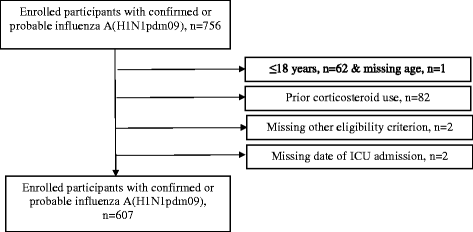The influence of corticosteroid treatment on the outcome of influenza A(H1N1pdm09)-related critical illness
- PMID: 27036638
- PMCID: PMC4818504
- DOI: 10.1186/s13054-016-1230-8
The influence of corticosteroid treatment on the outcome of influenza A(H1N1pdm09)-related critical illness
Abstract
Background: Patients with 2009 pandemic influenza A(H1N1pdm09)-related critical illness were frequently treated with systemic corticosteroids. While observational studies have reported significant corticosteroid-associated mortality after adjusting for baseline differences in patients treated with corticosteroids or not, corticosteroids have remained a common treatment in subsequent influenza outbreaks, including avian influenza A(H7N9). Our objective was to describe the use of corticosteroids in these patients and investigate predictors of steroid prescription and clinical outcomes, adjusting for both baseline and time-dependent factors.
Methods: In an observational cohort study of adults with H1N1pdm09-related critical illness from 51 Canadian ICUs, we investigated predictors of steroid administration and outcomes of patients who received and those who did not receive corticosteroids. We adjusted for potential baseline confounding using multivariate logistic regression and propensity score analysis and adjusted for potential time-dependent confounding using marginal structural models.
Results: Among 607 patients, corticosteroids were administered to 280 patients (46.1%) at a median daily dose of 227 (interquartile range, 154-443) mg of hydrocortisone equivalents for a median of 7.0 (4.0-13.0) days. Compared with patients who did not receive corticosteroids, patients who received corticosteroids had higher hospital crude mortality (25.5% vs 16.4%, p = 0.007) and fewer ventilator-free days at 28 days (12.5 ± 10.7 vs 15.7 ± 10.1, p < 0.001). The odds ratio association between corticosteroid use and hospital mortality decreased from 1.85 (95% confidence interval 1.12-3.04, p = 0.02) with multivariate logistic regression, to 1.71 (1.05-2.78, p = 0.03) after adjustment for propensity score to receive corticosteroids, to 1.52 (0.90-2.58, p = 0.12) after case-matching on propensity score, and to 0.96 (0.28-3.28, p = 0.95) using marginal structural modeling to adjust for time-dependent between-group differences.
Conclusions: Corticosteroids were commonly prescribed for H1N1pdm09-related critical illness. Adjusting for only baseline between-group differences suggested a significant increased risk of death associated with corticosteroids. However, after adjusting for time-dependent differences, we found no significant association between corticosteroids and mortality. These findings highlight the challenges and importance in adjusting for baseline and time-dependent confounders when estimating clinical effects of treatments using observational studies.
Figures
References
-
- World Health Organization. Pandemic (H1N1) 2009. Update 74. 13 November 2009. http://www.who.int/csr/don/2009_11_13/en/index.html. Accessed 22 February 2016.
-
- World Health Organization, Global Influenza Surveillance and Response System (GISRS). Influenza laboratory surveillance information. http://gamapserver.who.int/gareports/Default.aspx?ReportNo=6. Accessed 22 February 2016.
Publication types
MeSH terms
Substances
Grants and funding
LinkOut - more resources
Full Text Sources
Other Literature Sources
Medical


